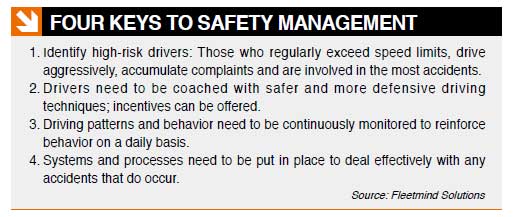“The rising price of fuel has made telematics for fleet management systems even more critical to all types of fleets,” said Craig Whitney, VP of Marketing at Networkfleet. Seeking ways to ensure fleets remain profitable is the main reason fleet managers use telematics. In the U.K., for instance, diesel prices rose 36 percent from 2010 to 2011. “Our clients use telematics to reduce operation costs, including lower fuel consumption and vehicle maintenance.”
“The rising price of fuel has made telematics for fleet management systems even more critical to all types of fleets,” said Craig Whitney, VP of Marketing at Networkfleet. Seeking ways to ensure fleets remain profitable is the main reason fleet managers use telematics. In the U.K., for instance, diesel prices rose 36 percent from 2010 to 2011. “Our clients use telematics to reduce operation costs, including lower fuel consumption and vehicle maintenance.”
According to a study from the University of Michigan Transportation Research Institute, ignoring fuel-saving strategies such as vehicle maintenance, driver training and route selection can reduce a vehicle's cumulative fuel efficiency by about 45 percent. Aggressive driving and vehicle idling are major sources of fuel waste, as is excessive speeding.
Features like safety belt status, idling, speed violation alerts and reports, and kilometers-per-liter/ miles-per-gallon monitoring can not only reduce fuel consumption by 8 to 10 percent, but also reduce overall operating costs by 10 to 20 percent, Whitney said.
Unauthorized vehicle use is another source of fuel waste. “GPS tracking provides vehicle movement 24/7, which allows our customers to be alerted if there is movement after hours or at any irregular time of day,” said Mark Roberts, CMO of NexTraq. Improved routing is another way to reduce fuel costs so that managers can dispatch drivers more efficiently and reduce overall driving distances.
According to a 2011 U S Environment Protection Agency study, failing to properly maintain the engine or check the tires can hurt fuel efficiency. The study indicated that “fixing a car that is out of tune or failed an emission test can improve its gas mileage by an average of 4 percent, while fixing a faulty oxygen sensor can improve mileage by as much as 40 percent.”
Engine diagnostics monitoring, including fuel usage and emissions, helps with anticipating and fixing critical vehicle or equipment issues, thus avoiding costly failures or maintenance costs, while keeping engines and fuel performance in optimal conditions, Whitney said. “In the future, these systems will gather more data from engines through sensors, and then combine that data with predictive statistics to help identify and diagnose potential sources of problems.”
Reduced Labor Cost
Payroll fraud and inefficient use of labor and resources are concerns for fleet managers. “With GPS, telematics reports can be used to track authentic work hours, reducing timesheet and payroll errors,” said Jason Lai, Director of Fleet Management Service, Riti Technology. “The system can also indicate if drivers aggregate in a location other than the service yard to take an unauthorized break together. It allows company executives and fleet managers to track vehicles, employees, driving routes and actual hours spent on the job.”
When drivers know their behavior and workday profiles are monitored, they behave. “One of our clients' payroll expenses have decreased by 12 percent with more accurate labor costs,” Roberts said.
Property Loss = Productivity Loss
Landscaping, construction and mining vehicles often transport expensive assets. “When heavy machinery is lost, stolen or missing, it can lead to significant losses for your business,” said Todd Lewis, President of GPS North America. “You face not only the cost of replacing those assets, but also the lost productivity and customer satisfaction when employees can't perform as planned.” For instance, a minor scrape in a mine could cost a company millions in revenue. “One of our landscaping customers recovered more than $400,000 worth of vehicles and equipment with our solution,” Roberts said.
Efficient Dispatch
For taxi and limo fleet managers, detailed location and best time-saving route information offer the most value for dispatching vehicles, Whitney said. “Customer satisfaction is also improved due to the ability to track vehicle location and dispatch the nearest vehicle.”
For mass-transit buses, it is also important for these vehicles to arrive on time. Through the integration of mobile DVR, GPS, dispatch software, stop announcement system and other onboard electronics, estimated arrival times can be provided to maximize driver efficiency and passenger satisfaction, said Xin Zhou, Product Manager, Hikvision Digital Technology..
Fleet managers can see where their vehicles are, and they can automate processes such as routing, tracking or reporting, Roberts said. Drivers may spend too much time on the road because they do not know the quickest way to their destination. “One customer was able to increase fleet productivity by 35 percent.”
All-in-One Solutions
Rising fuel prices may be a driving force for the adoption of fleet management solutions. “It took years for one of our clients to finally deploy our solution. What made the customer hesitant was that they were not sure if the ROI was positive and how fast the ROI would be gained,” Lai said. Payback periods vary greatly with the execution skill of the fleet manager and the scale of fleets.
“In a traditional setting, the functions of DVRs and telematics devices are mutually exclusive; mobile DVRs record while telematics devices track through GPS,” Zhou said. “With increasingly available 3-G networks, telematics devices are gradually replaced by more powerful mobile DVRs since customers no longer invest in two devices with similar capabilities.” Having a visual recording/transmitting component included with a reliable telematics service provides a layered and comprehensive mobile solution.
“Many DVR providers are offering cellular-based tracking services, while numerous GPS providers are working with DVR providers that have adopted an open-system approach with published APIs,” said Chalon Dilber, Marketing Director for Safety Vision. “Due to the extremely fragmented nature of both markets, combined with a relatively closed approach taken by providers, collaboration remains an exception rather than industry norm.”
Integration takes time to schedule and develop, Zhou said, since coordination among hardware manufacturers, software developers and clients is required. “The whole process could easily take a couple of months, if not more.”
Once integrated, all user-designated events with associated video, audio and metadata are downloaded to a central management system, which allows users to view, grade and respond to events at their convenience. Dilber said. “The central management software can also archive event videos based on user-defined priorities or severity of events, thereby ensuring that visual evidence of critical events is always available.”
Amid this economic uncertainty, mobile surveillance and telematics solution providers are advised to look at new service models and solution offerings to stay in business. Safety and efficiency are the core of fleet management and operations. It is financially and operationally sound to think outside the box to better cater to the needs of different fleet types.
